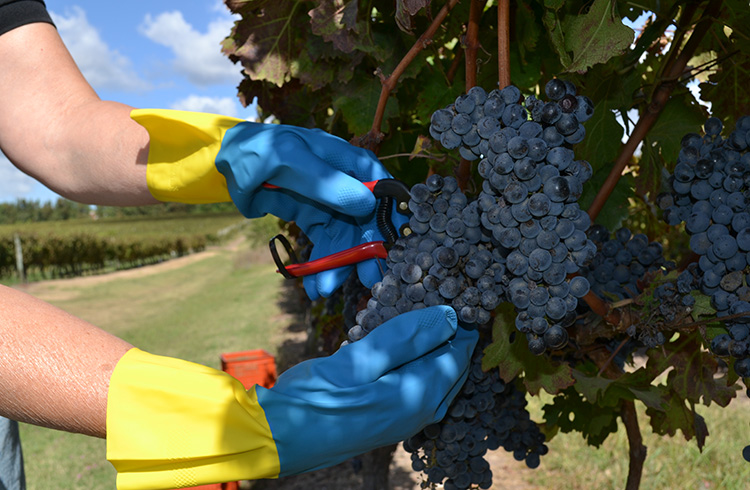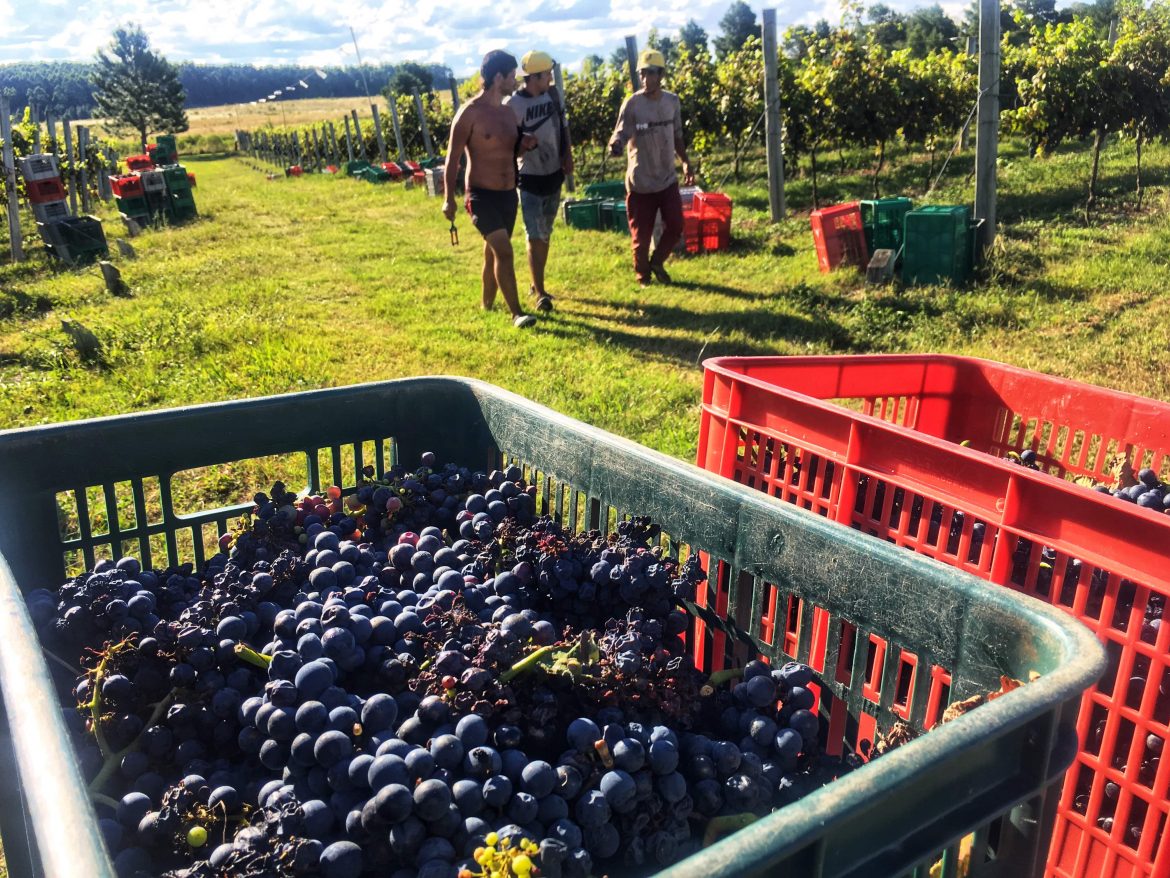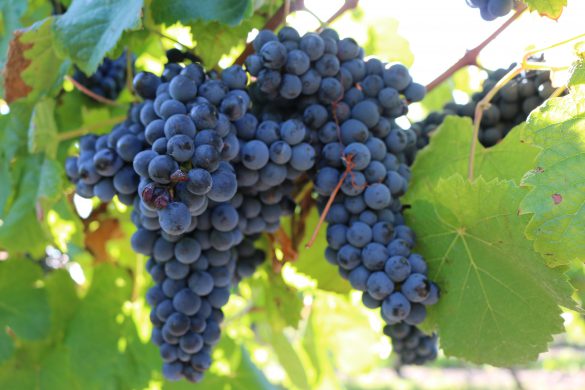Guide to vintages & harvests in Uruguay’s wine regions
Uruguay has some of the more variable vintages in South America. With the main wine regions along the coastline, the maritime climate can range from drought years to heavy downpours and even the occasional cyclone! That being said, Uruguay’s winemakers and viticulturists are extremely well-experienced at the great variation of climate during the harvest and are well-versed in changing their vineyard management based on the changing weather forecast.
“It’s the climate that makes making wine in Uruguay really exciting,” says Bouza winemaker Eduardo Boido. “Each vintage is different and we are always on our toes!”
The major factor impacting the different vintages is rain. Take a comparison between 2018 and 2019 in Canelones, for example: in January 2018 it only rained 35mm, whereas in January 2019 it rained 175mm!
Average temperatures are also important to the character of the harvest, however, temperature ranges are less extreme than experienced in the continental climates of Argentina and Chile. “Unlike many desert terroirs in the New World of viticulture, the climate in Uruguay is similar to the Old World,” explains Bodega Garzon‘s head viticulturist Eduardo Felix. “Every year is different because of the rainfall.”
Quick reference guide to wine harvests in Uruguay
2022: A rather ‘classic’ vintage, cool and wet. Best for coastal whites, and fresher light, reds.
2021: A classic vintage for Uruguay with relatively cool, balanced season and a slightly bigger crop.
2020: A very good year with a dry, warm vintage with an excellent balance in whites and reds.
Uruguay vintage guide 2022
A warm spring then turned into a cool and wet summer, meaning that in Vintage 2022 attention and extra hours of canopy management were required in the vineyard. Refreshing and fragrant coastal white wines are most promising, and the reds offer a return to the brighter, lighter style of Uruguay.
EXPECT: Fresh whites with layered aromatics, and nuanced, lighter reds.
BEST FOR: Coastal white wines of Albariño and Chardonnay; high-end Pinot Noir; lighter styles of Tannat.
WORST FOR: Don’t expect anything too full-bodied or rich in 2022.
There were some very high temperatures in January, which brought the season foreward, but then we had a lot of rain from mid-January through to March and a cool summer. We have excellent quality white wines from this cooler vintage – particularly Albariño and Chardonnay – and also excellent Pinot Noir.”
Santiago Deicas, winemaker at Familia Deicas and Juanico
We did have more rain this year, but it wasn’t excessive. The average temperature was good, and we were able to reach full ripeness with concentrated aromas and flavours. Although we have lighter alcohol levels this year.
Fiorella Faggiani, winemaker Alto de la Ballena in Maldonado
When the rains came at the middle of the harvest, we had to rethink the vintage instead seeking freshness and less structure – especially in our red wines. Tannat wines this year are fresher and lighter in colour but with tension and minarality.
Gabriel Pisano, winemaker at Viña Progreso
A winemaker’s perspective with Duncan Killiner at Cerro del Toro in Maldonado
View this post on Instagram
Uruguay vintage guide 2021
2021 was quite a typical Uruguayan vintage with a relatively long ripening period and a slightly larger crop than usual (6% up from 2020). It was a larger harvest than normal, despite some heavy rains in February.
EXPECT: Classic wines with balance and the typically lower alcohol levels (12.5%)
BEST FOR: The early-ripening and late-ripening varieties that avoided the rain. Tannat did very well in quality and quantity.
WORST FOR: Pinot Noir and varieties that are usually picked in February (when there were heavy rains).
“It was a relatively normal vintage for us in Canelones in 2021, with a long ripening period. I’m very happy with the red and white varieties, from our Viognier to our Tannat. We had very good balance this year, the sugar level, pH and tannins are what we expect from a normal year. The Tannat was able to mature nicely but was still very fresh with good acidity.”
Gabriel Pisano, winemaker Viña El Progreso in Canelones
Uruguay vintage guide 2020
2020 was similar to 2018 in many ways, and producers are equally as excited about the quality, although temperatures were a bit more balanced providing more nuanced and balanced white and red wines.
EXPECT: Fresh and balanced white wines, and concentrated and balanced red wines.
BEST FOR: Great vintage across the board.
WORST FOR: Varieties that needed picking in the wetter latter half of February (late-ripening whites).
Most of the year’s rain was concentrated to the winter, allowing for a dry and warm summer.
We had excellent Spring rains in 2019, and then in January, February and March [harvest season] the weather was perfect! We had some heat spikes in January, but then in February some rain helped ‘relax’ our Tannat in the vineyards, which needs some humidity to balance its tannins, sugar and acidity. We had perfect health in the grapes and our pH levels were historically low. There are a lot of similarities with the wines of 2018, but I think 2020 is even more balanced.”
Santiago Deicas, Winemaker at Familia Deicas in Canelones
Click here to read our Tannat guide, the champion of Uruguayan wine!
Uruguay vintage guide 2019
2019 saw a really rainy summer which made vineyard management more demanding for producers across the country. The resulting wines have less intensity and concentration as 2018, but have good freshness.
EXPECT: Fresher, lighter-bodied wines with less concentration.
BEST FOR: Fresh, coastal white wines.
WORST FOR: Full-bodied reds didn’t reach the same concentration as in warmer years.
The rainfall was above average in December and January, so we had to work really hard to maintain the quality and the health of the grapes. Luckily, in February, the weather was good which allowed the varieties such as Tannat, in particular, to develop during the ripening process. The vines of Pan de Azucar/Maldonado managed to withstand the high water regime because of the rocky soil and its high drainage. We had to cut back the roots a bit more in order to lower the yield and therefore maintain the best quality possible; resulting in a lower yield for some early harvest varieties such as Tempranillo.
“The wines are still quite young but the whites (Chardonnay, Albariño and Riesling) are very fresh with a good level of acidity. The Tannat has a very strong colour intensity, which is something that I was not expecting, and they are already very rounded in the mouth with a lower intensity of tannins. Of course, the colour of the Merlot and the Pinot noir is less intense than previous harvests.”
Eduardo Boido, winemaker at Bodega Bouza (Canelones & Maldonado)
From mid-December to mid-January, rainfall was higher than normal. This meant that we had to be extra careful with the management of the canopy (defoliation, tipping and toping) to control the growth. In mid-January, the heavy rain stopped and we had a dry summer with cold nights, which helped the grapes to ripen. The start date of harvest was normal, but we finished a few days early. Yields were lower than expected by around 10%. The wines, in general, had a moderate alcoholic content and a higher level of acidity and freshness.”
Eduardo Feliz, Agronomist at Bodega Garzon
Uruguay vintage report 2018
One of the best vintages in Uruguay’s History, 2018 is the vintage everyone will be talking about for some time. Dry weather, technically a drought, wasn’t good for the massive agriculture industry however it offered ideal conditions for wine producers. Great ripeness, pure fruit expression and steady maturation made for balanced wines.
EXPECT: Rich wines with great ripeness and higher alcohol levels.
BEST FOR: Full-bodied red wines, especially Tannat.
WORST FOR: The farming industry… but there’s plenty of good wine around to ease the woes!
The favourable conditions of the climate, which, like the 2015 harvest, were reminiscent of a Mediterranean climate and allowed each variety to be harvested at its optimum maturity. Including sparkling wine, young wines and fresh, reservations, or Icon.
It is a vintage to remember, to enjoy the whole spectrum of wines that come from it and perhaps can be valued as the best vintage of these 19 harvests of the new millennium!”
Néstor Merino, agronomist Pizzorno Wines

Uruguay Vintage Guide 2017
A rainy month of January was problematic and worrying for growers but as the skies cleared in February, winemakers were able to harvest with relatively good maturation. A surprising harvest which, although it didn’t get off to the best start, ended with good production and quality.
EXPECT: Reasonably balanced wines
BEST FOR: Later ripening varieties like Tannat which reached better concentration in the drier months later in the season
WORST FOR: White wines can be a bit dilute
Although in the white varieties we reach a fair maturity but not with a level of concentration in sugars similar to what was the previous harvest 2015-2016. In the red varieties, and in particular Tannat, grapes reached an optimum maturity with very good levels of concentration and balance between sugars and acidity. The 2017 vintage is balanced.”
Néstor Merino, agronomist Pizzorno Wines
Uruguay vintage report 2016
“2016 was a very good year, similar to 2018 in some ways. It was a very dry summer and the grapes matured really well, and were able to make wines with better concentration and good fruit expression,” says Eduardo Boido, winemaker at Bouza and University Professor.
Uruguay harvest report 2015
“2015 we had some rain at the end of December and January, and then we had clearer weather. The whites were very fresh but we also got good concentration in our later ripening varieties,” remembers Eduardo Boido.
Uruguay vintage report 2014
“2014 was a really bad and difficult vintage – it was dry in spring but we had much more rain than normal during the summer,” says Eduardo Boido, winemaker at Bouza and University Professor. “It was raining until mid-February. It was hard to reach maturity with the grapes, and we really had to work for it.”
Uruguay harvest report 2013
“We had some hail in Canelones (mainly in the Melilla and El Colorado region) which arrived just before the harvest and so we lost some of our Chardonnay,” remembers Eduardo Boido, winemaker at Bouza. “But for the rest it was quite a normal vintage, despite the significant losses.”
Uruguay vintage report 2012
“It was a bit rainier than normal but it wasn’t a bad harvest, we were able to mature the grapes. A relatively normal, rainier vintage,” says Eduardo Boido, winemaker at Bouza and University Professor.
Uruguay vintage report 2011
“2011 was an excellent year, we had excellent maturation and there was no pressure from the climate to harvest so we could harvest when we wanted,” remembers Eduardo Boido, winemaker at Bouza. “It was a warmer year, so much more mature fruit than summer.”
Uruguay harvest report 2010
“It was a normal year, but with a bit more rain than normal,” says winemaker Eduardo Boido. “It wasn’t the best but nor was it too complicated.”
Uruguay vintage report 2009
“2009 was a very good year, which also had a dry summer but it was a bit fresher,” explains Eduardo Boido, winemaker at Bouza. “The grapes were fresher but also mature.”
Uruguay vintage report 2008
“2008 had a very special characteristic,” recollects Eduardo Boido. “The rain was lower, and we were able to harvest out whites and early red varieties nicely, but then it rained for 15 days non-stop! It was hard for the medium cycle varieties, although Tannat managed to come through ok.”

